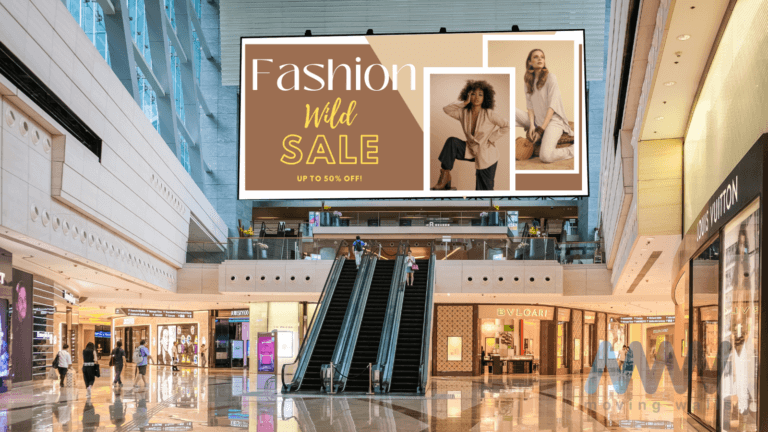Stepping up the retail game – why you should consider Programmatic DOOH to drive footfall to your venues
Picture this: you’re scrolling through your social media feed and you come across yet another sponsored ad for a product you’ve never heard of. You don’t even bother clicking on it because, let’s face it, you’ve been bombarded with so many digital ads lately that they’ve all started to blend together. As a consumer, it’s easy to feel overwhelmed and jaded by the constant barrage of online advertising.
But as a retail brand, how do you break through the noise and capture the attention of your target audience? Enter out-of-home advertising. This isn’t your average billboard on the side of the road. We’re talking about innovative, interactive, and downright cool displays that catch your eye and leave a lasting impression.
Fusing Digital and Physical Media
Think about walking down the street and seeing a giant installation that lets you step inside and experience a brand’s product for yourself. Or stumbling upon a creative and clever ad campaign on the side of a building that makes you stop and think. These are the types of out-of-home ads that are changing the game for retail brands.
We are not making this up. Here’s a real-life example, in 2016, the most loved sneakers brand Nike wanted to step up its game. To be experiential, relevant and personal. Nike created a high-tech running track over a city block in Manila, Philippines during the 2016 Olympic Games, where runners could engage in virtual race against avatars of themselves. But why did Nike do all that? Nike wanted to cut through the noise to announce the launch of its latest footwear. So instead of creating an ad, it created an experiential digital signage.
Stepping up the Retail Game
As the retail industry continues to evolve, it’s essential to stay ahead of the game when it comes to advertising. One way to do this is by considering programmatic digital out-of-home (PDOOH) advertising.
PDOOH allows for real-time bidding and ad placement on digital screens in public places. This type of advertising is gaining popularity as it offers more efficient and targeted advertising.
At Moving Walls we’ve had first-hand experience working closely with brands and agencies that have chosen to use PDOOH as an integral element of their marketing mix. Here are some of their reasons why it works.
Wider Audience Nets
Firstly, PDOOH provides the opportunity to reach a wider audience. With programmatic and digital advertising, ads can be displayed on multiple screens in high-traffic areas such as shopping malls, airports, and train stations. This means that the brand’s message is exposed to a larger number of people, increasing the chances of generating leads and sales.
Closer Touchpoints
Take, for example, a shoe store that is launching a new range of sneakers. Using PDOOH, the store can display its ads on digital screens in various malls and train stations in the city. This ensures that the ads are seen by a diverse group of people, ranging from teenagers to adults. Similarly, retail spaces now boast of digital signage which acts as touchpoints, this way DOOH screens near relevant outlets can be activated with directional messages to visit the nearest store.

Targeted Advertising
Secondly, PDOOH allows for more targeted advertising. Retail brands and buyers can use programmatic advertising to target specific demographics and locations. For example, if a retail store wants to target young adults in a specific area, they can program their ads to appear on screens in that location during specific hours of the day.
A fashion brand can use programmatic advertising to display its ads in shopping malls located in upscale neighbourhoods. This ensures that the brand’s message is exposed to its target market, increasing the chances of generating sales. With platforms and services provided by Moving Walls, executing an OOH campaign today is just as simple as posting an ad on meta.
Flexibility and Ease of Ad Placement
Moreover, programmatic advertising provides more flexibility when it comes to ad placement. Retail brands and buyers can choose the duration and timing of their ads, ensuring that they are displayed at the most optimal times.
For instance, a retail store that is launching a seasonal sale can use programmatic advertising to display its ads during peak shopping hours. This ensures that the ads are seen by shoppers who are most likely to make a purchase. I bet you saw the 11:11 sale far too many times or the Year End Sale splashed all over the place.
Real-time understanding of Performance
Retail brands and buyers can monitor the effectiveness of their ads and make changes in real time if needed. This ensures that the brand’s message is constantly optimized for maximum impact.
There are a few ways to do this. The most common and scaleable one is to work with mobile location data providers who can attribute DOOH exposure to physical location visits. This is usually done by studying a sample of controlled vs exposed audiences.
Retailers may also work with research companies for more qualitative results. While this may be more expensive, there is the advantage of understanding audience feedback to the creatives, their dwell times, and also assessing brand recall.
To sum up, PDOOH offers several advantages for retail brands and buyers. From reaching a wider audience to more targeted advertising, programmatic advertising provides a flexible and efficient way to promote your brand. With real-time data on ad performance, retail brands and buyers can ensure that their message is optimized for maximum impact. So why not consider out-of-home programmatic advertising for your next marketing campaign?
Also, read: